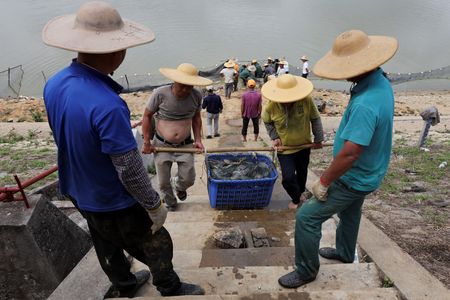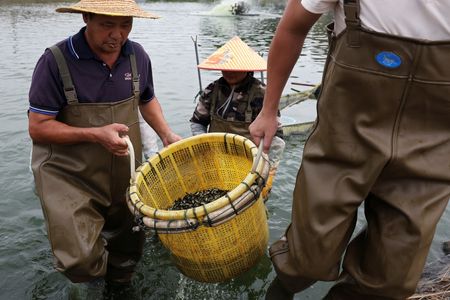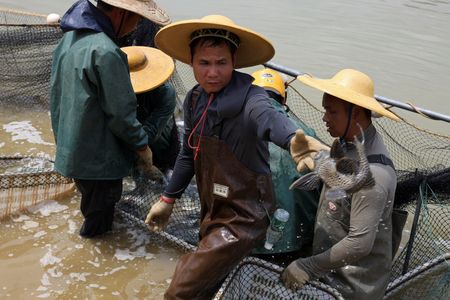By Ella Cao, Xiaoyu Yin and Florence Lo
MAOMING, China (Reuters) -In Maoming, a southern Chinese city where a giant tilapia statue watches over traffic at an intersection, the fish isn’t just a budget-friendly dinner, but a profession, income and way of life for thousands.
Today, all of that is at risk from the trade war.
An area roughly one and a half times the size of San Francisco is given over to tilapia farms in Maoming. Fish nurseries and feed lots in turn sustain the farms. Sixteen factories dot the city churning tilapia into fillets for export, much of it to supermarket freezers in the U.S..
Several rounds of U.S. tariffs mean China’s $425 million in tilapia exports to the United States are subject to duties of 170%, all but pricing them out of their largest export market.
In late April, fish nurseries in Maoming visited by Reuters talked of not getting orders for new fry; feed makers said customers are cutting back. Processors are idle and many farmers say they are making losses at today’s prices.
Tongwei, one of China’s biggest aquaculture businesses, said this month that one-in-10 tilapia farmers in the country could lose their jobs.
“These high tariffs have hit us brutally,” said Huang Songfei, a longtime buyer in Maoming. “The whole chain is hurting. People are at risk of losing their jobs.”
Tilapia may be a small segment of trade between the U.S. and China but the threat to livelihoods in Maoming is also being felt in both countries as the trade war throws up massive tariffs on imports.
Or, as Huang, put it: “We’re stuck.”
TO BREED OR NOT TO BREED
March to May is usually the peak stocking season for tilapia. Recently hatched fish are typically in high demand, swiftly sold and sent off to farmers. This spring, orders are scarce.
“This is the hardest year ever,” a worker said, asking not to be identified. “Normally, we’d have sold a lot by now. But no one’s buying. Farmers are scared.”
Her boss said sales have fallen by more than half.
“Some aren’t even exporting to the U.S., but they are panicking anyway,” he said, also requesting anonymity. “It’s a chain reaction.”
Tilapia prices crashed 17% in early April as Washington and Beijing traded tariff blows. Despite a modest recovery, prices are dangerously low and some farmers are struggling to make ends meet, Huang said.
The city’s 16 export processors are also struggling. They once exported about 100,000 tonnes of tilapia a year, mostly to the United States and Canada, according to the local government, enough to satisfy the average annual fish intake of 25 million Americans.
“If this keeps going, everyone will go bankrupt,” said Zhu Huazhi, a buyer for several processing plants. More than 60% of their tilapia once went to the U.S..
SEARCHING FOR A LIFELINE
In nearby Hainan province, the U.S. accounts for half of its tilapia exports and the local aquatic products’ association urged companies this month to find new markets at home and abroad.
However, replacing American demand is difficult. While markets exist in the European Union, Africa and the Middle East – they can’t quickly or completely replace U.S demand. Africa, for example, largely imports whole fish with minimal processing, according to a tilapia exporter.
The domestic economy is no easy fix either. The local market is weak, consumers are cautious and spending is slow.
In Maoming, people are pinning their hopes on a trade deal.
“We’ll see who can survive this,” Zhu said. “I believe in China’s economy. If the tariffs are resolved, orders will come back.” ($1=7.2995 Chinese yuan renminbi)
(Reporting by Ella Cao, Xiaoyu Yin and Florence Lo in Maoming; Editing by Lewis Jackson and Neil Fullick)















